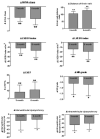Cardiac resynchronization therapy upregulates cardiac autonomic control
- PMID: 18479331
- PMCID: PMC2756798
- DOI: 10.1111/j.1540-8167.2008.01190.x
Cardiac resynchronization therapy upregulates cardiac autonomic control
Abstract
Objective: To determine the effect of cardiac resynchronization therapy (CRT) on sympathetic nervous function in heart failure (HF).
Background: Neurohormonal dysregulation and cardiac autonomic dysfunction are associated with HF and contribute to HF progression and its poor prognosis. We hypothesized that mechanical resynchronization improves cardiac sympathetic function in HF.
Methods: Sixteen consecutive patients receiving CRT for advanced cardiomyopathy and 10 controls were included in this prospective study. NYHA class, 6-minute walk distance, echocardiographic parameters, plasma norepinephrine (NE) were assessed at baseline, 3-month and 6-month follow-up. Cardiac sympathetic function was determined by (123)iodine metaiodobenzylguanidine ((123)I-MIBG) scintigraphy and 24-hour ambulatory electrocardiography.
Results: Along with improvement in NYHA class (3.1 +/- 0.3 to 2.1 +/- 0.4, P < 0.001) and LVEF (23 +/- 6% to 33 +/- 12%, P < 0.001), delayed heart/mediastinum (H/M) (123)I-MIBG ratio increased significantly (1.8 +/- 0.7 to 2.1 +/- 0.6, P = 0.04) while the H/M (123)I-MIBG washout rate decreased significantly (54 +/- 25% to 34 +/- 24%, P = 0.01) from baseline to 6-month follow-up. The heart rate variability (HRV) measured in SD of normal-to-normal intervals also increased significantly from baseline (82 +/- 30 ms) to follow-up (111 +/- 32 ms, P = 0.04). The improvement in NYHA after CRT was significantly associated with baseline (123)I-MIBG H/M washout rate (r = 0.65, P = 0.03). The improvement in LVESV index was associated with baseline (123)I-MIBG delayed H/M ratio (r =-0.67, P = 0.02) and H/M washout rate (r = 0.65, P = 0.03).
Conclusion: After CRT, improvements in cardiac symptoms and LV function were accompanied by rebalanced cardiac autonomic control as measured by (123)I-MIBG and HRV.
Figures





References
-
- Himura T, Felten S, Kashiki M, Lewandowski T, Delenhanty J, Liang C. Cardiac noradrenergic nerve terminal abnormalities in dogs with experimental congestive heart failure. Circulation. 1993;88:1299–1309. - PubMed
-
- Zucker I, Wang W, Pliquett R, Lie J, Patel K. The regulation of sympathetic outflow in heart failure. The roles of angiotensin II, nitric oxide, and exercise training. Ann N Y Acad Sci. 2001;940:431–443. - PubMed
-
- Lombardi F, Porta A, Marzegalli M, Favale S, Santini M, Vicenti A, De Rosa A. Heart rate variability patterns before ventricular tachycardia onset in patients with an implantable cardioverter defibrillator. Participating investigators of ICD-HRV Italian Study Group. Am J Cardiol. 2000;86:959–963. - PubMed
-
- Meredith I, Broughton A, Jennings G, Esler M. Evidence of a selective increase in cardiac sympathetic activity in patients with sustained ventricular arrhythmias. N Engl J Med. 1991;325:618–624. - PubMed
Publication types
MeSH terms
Substances
Grants and funding
LinkOut - more resources
Full Text Sources
Other Literature Sources
Medical
Research Materials
Miscellaneous

